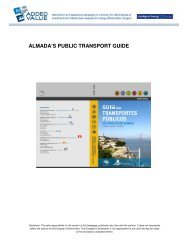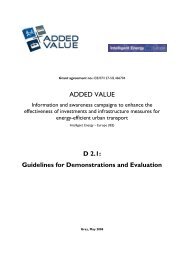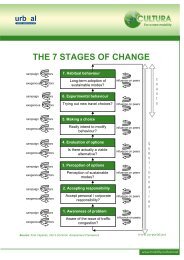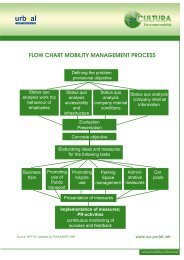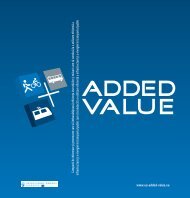SUMO - Eltis
SUMO - Eltis
SUMO - Eltis
You also want an ePaper? Increase the reach of your titles
YUMPU automatically turns print PDFs into web optimized ePapers that Google loves.
Much is to be gained by planning a project using the <strong>SUMO</strong> system. Careful systematics<br />
is essential in the planning, implementation and evaluation of projects. By setting<br />
targets at the outset of a project it is easier to achieve better results both for individual<br />
projects and for other projects which will benefit from experiences that have been documented<br />
and monitored.<br />
3.2 <strong>SUMO</strong> ANALYSIS LEVELS<br />
<strong>SUMO</strong> is based on tested methods and an idea to measure effects at different levels. The<br />
process that describes the evaluation procedure is illustrated in Figure 3.1. The design<br />
of <strong>SUMO</strong> is simple and the methods included are not significantly different from other<br />
guidelines for evaluations. However, <strong>SUMO</strong> is unique in how its targets, indicators,<br />
and results can be specified at different levels. The different levels follow on from each<br />
other. The system using levels enables the early measurement of the impact of the project.<br />
It is often useful to measure at several different levels, but not always necessary or<br />
even applicable. The type of project determines which analysis levels are applicable.<br />
Sometimes certain levels simply do not exist, sometimes these can be extremely difficult<br />
to measure.<br />
The two upper levels are a description of the background and preconditions for the<br />
measures. The following levels in the model are measurable against different time horizons.<br />
Level A, “Useful achievements”, is measured within or as directly linked to a project,<br />
while the others are measurable retroactively as measures begin to have an impact.<br />
All levels may not be relevant for all types of measures.<br />
The different analysis levels are the real core of <strong>SUMO</strong>. In addition, <strong>SUMO</strong> includes a<br />
description of the process that is required to be able to use and benefit from these levels.<br />
<strong>SUMO</strong> also works from an organisational perspective. In a company or organisation<br />
that works with transports as a part of its management system, this could concern<br />
measuring:<br />
• the number or percentage that are interested in a particular measure (level C)<br />
• how well employees have understood decisions in the field (level D)<br />
• the number or percentage that have accepted decisions and are planning to change<br />
behaviour (level E)<br />
• the number or percentage that have changed behaviour based on decisions (levels F<br />
and H)<br />
• experiences of those that have changed behaviour (level G).<br />
(See Figure 3.1 on the following page.)<br />
3.3 WHEN CAN <strong>SUMO</strong> BE USED?<br />
<strong>SUMO</strong> can be used for most projects and measures that aim to influence attitudes and<br />
behaviour in traffic. MOST-MET was developed to measure the effect of mobility<br />
management measures, which concerned influencing attitudes and behaviour. The<br />
method can therefore be used for other projects and measures with a similar goal, such<br />
as road safety projects. The <strong>SUMO</strong> approach can also be used to evaluate traditional<br />
physical measures when these are combined with information, or for <strong>SUMO</strong>-inspired<br />
sumo – System for Evaluation of Mobility Projects<br />
WHAT IS <strong>SUMO</strong>?<br />
13



